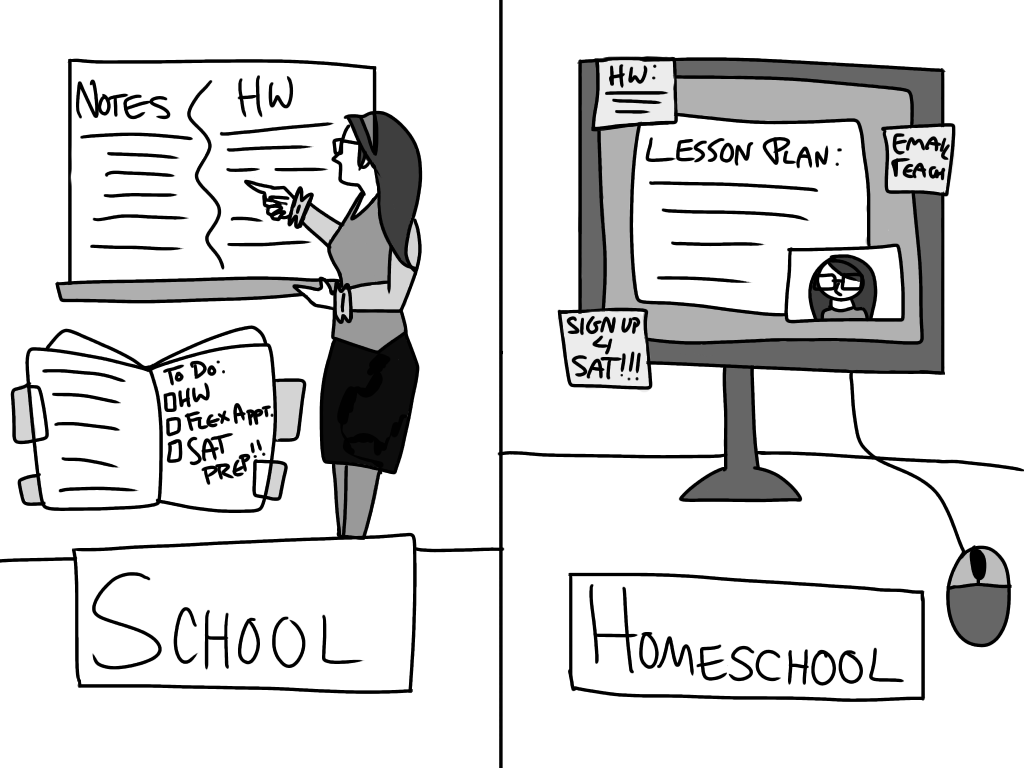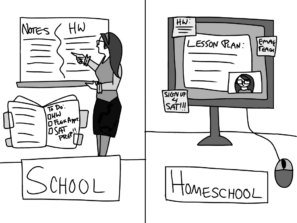

Get up. Go to school. These are the two cornerstones of the scholastic morning routine, the bare minimum that characterizes the start of every student’s day. You cannot go to school asleep — though you can nap at your own peril once you arrive — and you cannot go to school without being to school. Except that you actually can, as paradoxical as it seems. This is not some clickbait life hack — this is the nature of homeschooling.
While for many, homeschooling may imply being completely disconnected from any school, according to counselor Josephine Ho, the school also uses the description for students who follow an Aragon curriculum from home. This is an option that is pursued by sophomore Sara Nasserzare, a student who has transitioned from a typical high school experience to an alternate education plan.
Though they are largely responsible for their own education at home, Nasserzare and other homeschool students coordinate closely with their teachers and the district.
While the nature of homeschool inevitably results in a less regimented daily schedule, there is still order to a student’s day.
“In addition to the few classes I take at Aragon, my daily routine is having a teacher come over from the district, working together for a few hours, and then, after she goes, I need to complete all my homework on my own,” Nasserzare said. “We’re always in contact with teachers at school … and while they’ve done a really good job communicating with us and everything, it’s still hard.”
Junior Connor Foote does not go to school in the traditional manner and is more reliant on online education services, only coming to school for certain classes that cannot be done online. This is an alternate type of education known as independent study, according to Ho.
“Basically, I go to Aragon for one class and I come back home, and then I have to work on the computer for a minimum of three hours on my three core classes, which are English, U.S. History and algebra,” Foote said.
The individualistic nature of homeschooling can have its benefits and detriments, and is often the largest adjustment that students who learn at home must make.
“A perk I would say is being one-on-one with a teacher, so you have more questions to ask, there’s more time, more help,” Nasserzare said. “At the same time, it’s just like a whole different world. In high school, you just go to your regular classes and do what they ask, but with homeschooling, it’s just emailing teachers, getting work, and doing it on your own time … It is a lot more personal responsibility.”
As anyone who has taken a driver’s education class in the 21st century can confirm, online classes can be pretty rough.
“I don’t know if you’ve ever done compass learning, it’s basically like: I just sit on there for three hours, and a person on the screen just lectures me, and I’m just sitting there like ‘yeah,’ ‘yeah,’ Foote said. “Then they’ll have little check in points and quizzes and even some online projects … without any real human interaction. It’s a pain.”
Homeschooling can be a foreign concept to many students who attend a traditional high school. Many know what it is, but few know how it really works, and even fewer can adequately empathize with those who are homeschooled. This can breed a plethora of misconceptions.
Nasserzare doesn’t believe that homeschooling always ends up hurting one’s social life.
“My friends are really good about it, my family’s really good about it,” she said. “Everyone’s just being really understanding about it.”
One of the more prevalent misconceptions about homeschooling is that it is the easy mode of education, but Nasserzare disagrees.
“Everyone thinks it’s really easy,” Nasserzare said. “It’s much harder than going to school because, besides working with the teacher from the district, I have to do a lot by myself. I have to dig in deeper with the work, with the textbooks, to try to understand what I need to.”
Each student learns in different ways, and even though homeschooling is at most a minor niche in education, only accounting for 3 percent of all students in the United States, it is important to know how it functions. More importantly, understanding and empathizing with those who are homeschooled helps to build a more cohesive academic community.
Additional reporting by Caroline Huang




